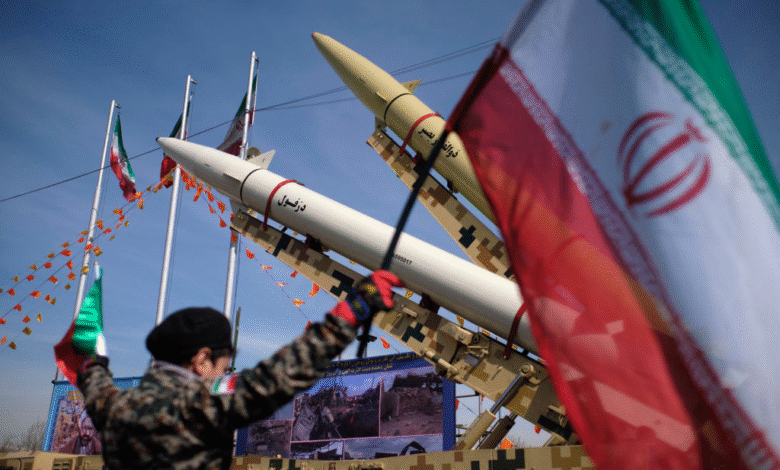Iran Nuclear Ambitions Obliterated After U.S. Strikes

Iran’s nuclear ambitions have been a focal point of international concern and contention, particularly in light of recent developments following U.S. strikes aimed at its nuclear facilities. Defense Secretary Pete Hegseth remarked that these strikes were not just about asserting military power but were strategically focused on mitigating threats posed by the Iranian nuclear program to national and regional security. The precision missions targeted key nuclear sites, including the infamous Natanz and Fordo facilities, which reportedly sustained severe damage during the operation. This decisive action, referred to as Operation Midnight Hammer, has raised questions about the future of Iran’s nuclear capabilities and the implications for U.S. foreign policy in the Middle East. As tensions escalate, the discourse surrounding Iran’s nuclear ambitions continues to evolve, underscoring the complex and precarious nature of global nuclear diplomacy.
The aspirations of the Iranian government to develop nuclear capabilities have created significant geopolitical turmoil, with many nations observing the developments closely. Following recent military actions, the focus has shifted to the implications for the region and the effectiveness of measures taken to address concerns linked to Tehran’s nuclear program. U.S. military responses, including targeted strikes on vital nuclear infrastructure, have sparked discussions on the strategies employed to counter potential threats. The complex narrative surrounding military interventions, such as Operation Midnight Hammer, reflects deeper issues concerning national security and international relations. As various factions express their views, it becomes clear that understanding the motivations and responses related to Iran’s nuclear initiatives is crucial for forecasting future diplomatic engagements.
Iran Nuclear Ambitions and U.S. Response
The recent U.S. military strikes against Iranian nuclear facilities have reignited discussions surrounding Iran’s nuclear ambitions. Defense Secretary Pete Hegseth’s assertive declaration that these ambitions have been ‘obliterated’ reflects the administration’s commitment to countering perceived threats from Tehran. This operation is perceived not just as a tactical maneuver but as a decisive action aimed at dismantling the infrastructure fueling Iran’s nuclear program, which has long been a concern for regional stability and U.S. national security.
The strikes specifically targeted three critical sites: Fordo, Natanz, and Isfahan, which are crucial to Iran’s nuclear progress. Despite the considerable damage reported by military officials, there is an acknowledgment that the complete annihilation of Iran’s capabilities may take time to assess fully. This operation, labeled ‘Operation Midnight Hammer,’ showcases the strategic intent of the U.S. to not only underscore its military prowess but also to reinforce its alliances in the region, particularly with Israel.
Operation Midnight Hammer: A Tactical Overview
Operation Midnight Hammer marks a significant escalation in the U.S. approach to Iran’s nuclear threats. Commissioned under the instruction of President Trump, this operation involved a precise and coordinated strike conducted by more than 125 aircraft. The inclusion of stealth B-2 bombers illustrates the meticulous strategic planning behind the operation, aiming to minimize communication and expose the targets to maximum destruction while evading Iranian defenses.
Military leaders, including Gen. Dan Caine, provided insights into the event’s execution during a press briefing at the Pentagon. The emphasis on minimizing civilian casualties while focusing on military targets reflects a broader U.S. military doctrine aimed at precision strikes. While initial assessments showed severe damage to Iran’s facilities, analysts suggest monitoring Iran’s future actions will be crucial as Tehran has vowed to utilize all means necessary to defend its sovereignty post-strike.
Implications of U.S. Strikes on Regional Stability
The U.S. air strikes have profound implications not just for Iran but for the broader Middle East landscape. The potential for retaliatory actions from Iran against U.S. forces or allies in the region could escalate tensions significantly. Iran’s Foreign Minister Abbas Araghchi’s statements indicate a readiness to respond, which suggests that the cycle of aggression between these entities could lead to an unstable environment in an already volatile region.
Moreover, the repercussions of this military action extend to diplomatic relations in the Middle East. Allies such as Israel have welcomed the U.S. strikes, reinforcing their stance against Iran’s nuclear program. However, adversaries and neutral nations may perceive this aggression as a violation of sovereignty, prompting them to reassess their alliances and military postures. The balancing act between deterrence and diplomatic engagement will be critical in the aftermath of these events.
The Future of Iran’s Nuclear Program Post-Strike
The damage inflicted on Iran’s nuclear facilities raises critical questions about the future of its nuclear program. While the U.S. administration claims that Iran’s nuclear ambitions have been severely weakened, experts warn that the program’s resilience and potential for recovery must not be underestimated. The ability of Iran to rebuild or adapt its infrastructure in response to these strikes will play a key role in shaping future diplomatic negotiations and military strategies.
As the situation evolves, it will be crucial for international observers and policymakers to monitor Iran’s next moves. The previous pattern of defiance and technological ambivalence exhibited by Iran suggests that instead of abandoning its ambitions, Tehran may seek alternative paths to circumvent sanctions and military deterrents. This underscores the need for continued vigilance and engagement on the part of the U.S. and its allies.
International Reactions to U.S. Military Action
International reactions to the U.S. strikes on Iran’s nuclear facilities have been quite polarized. Some allies, particularly Israel, have praised the operation as a necessary step to limit Iran’s nuclear capabilities, framing it as vital for maintaining regional security. Conversely, nations such as Russia and China have condemned the strikes, asserting that they complicate an already delicate situation and could lead to further instability.
The United Nations has called for restraint from all parties involved to avoid an escalation of conflict in the region. As discussions on international diplomacy progress, the divergent perspectives on the U.S. actions will shape future negotiations concerning Iran’s nuclear program. The response from allied nations could significantly influence the effectiveness of any diplomatic efforts moving forward.
Media and Public Perception of U.S. Action
Public and media responses to the U.S. strikes against Iran varied widely, reflecting different perspectives on military interventionism and national security. Supporters of the operation lauded its precision and the message it sends regarding U.S. commitment to protecting its national interests and allies. Commentators emphasized the need for strong action against threats posed by Iran’s nuclear facilities as justified in light of previous provocations.
On the contrary, critics have expressed concern over the potential for unintended consequences stemming from military actions. The fear is that such strategies might escalate tensions rather than resolve conflicts, potentially leading to a broader military engagement. Thus, the discussion surrounding Hegseth’s comments on the obliteration of Iran’s nuclear ambitions reflects not only military considerations but also the complex dynamics of public sentiment and media narratives.
The Role of Diplomatic Strategies Amidst Military Action
The striking balance between military action and diplomatic negotiation is crucial, particularly following operations like Midnight Hammer. While the objective is to remove immediate threats posed by Iran’s nuclear program, it is essential that U.S. leadership also emphasizes ongoing dialogue and diplomatic relations to prevent further escalation. Effective statecraft following military intervention can significantly alter the course of future engagements with Iran and encourage more stable relations.
Current U.S. policy must prioritize a dual approach—one that engages military readiness with strong diplomatic overtures. This could involve reassessment of sanctions, engagement with European allies to unify strategies, and restoring communication channels with Iran. Successfully navigating this path will determine whether U.S. actions lead to a de-escalation of tensions or further conflict.
Assessment of Damage to Iran’s Nuclear Facilities
Following Operation Midnight Hammer, assessments of damage to Iran’s strategic nuclear facilities—Fordo, Natanz, and Isfahan—revealed significant setbacks to their nuclear capabilities. Initial reports from military officials indicated that these sites sustained severe destruction, potentially hampering Iran’s enrichment activities for the foreseeable future. Yet, there remains a cautious emphasis on the part of military leaders that conclusions regarding the total incapacitation of Iran’s nuclear ambitions might be premature.
As military assessments continue, it will be important for stakeholders to comprehend the full scope of the recoverability of these facilities. If Iran can swiftly recalibrate its strategies and exert its technological prowess, the door remains open for them to reconstitute their nuclear ambitions despite the recent strikes. These developments necessitate ongoing scrutiny to ensure policies adapt to the evolving landscape.
Lessons Learned from Operation Midnight Hammer
Operation Midnight Hammer presents several critical lessons concerning military engagement. The operation highlighted the importance of strategic military planning and precision in targeting, aiming to create a significant impact on Iran’s nuclear ambitions while minimizing risk to U.S. personnel. Moreover, the operation showcases the complexities and logistical challenges that accompany such high-stakes military initiatives, serving as a case study for future actions.
Furthermore, the political and diplomatic responses to the operation reflect crucial lessons concerning the broader implications of military decisions. The necessity of coordinating military actions with diplomatic efforts is paramount to avoid exacerbating conflicts. Achieving a sustainable balance between deterrence and diplomacy will be vital, ensuring that national security goals are met without sacrificing the prospect of future negotiations.
Frequently Asked Questions
What are Iran’s nuclear ambitions and how do they pose a threat?
Iran’s nuclear ambitions refer to its desire and efforts to develop nuclear technology that could potentially be used for weapons production. This has raised concerns among international entities, including the U.S., due to fears that a nuclear-armed Iran would destabilize the region and threaten allies such as Israel. The United States perceives Iran’s nuclear program as a direct threat to national interests, prompting military responses like the recent U.S. strikes on Iranian nuclear facilities.
What was the impact of the U.S. strikes on Iran’s nuclear facilities?
The recent U.S. strikes aimed at Iran’s nuclear facilities, including Fordo, Natanz, and Isfahan, reportedly resulted in severe damage and destruction. According to U.S. Defense Secretary Pete Hegseth, these targeted operations were intended to neutralize the threats posed by Iran’s nuclear ambitions, suggesting a significant setback for the Iranian nuclear program, although the full extent of the damage is still under assessment.
How did Hegseth characterize the U.S. operation against Iran’s nuclear program?
Defense Secretary Pete Hegseth characterized the U.S. operation against Iran’s nuclear program as ‘focused, powerful, and clear,’ emphasizing that it was not aimed at regime change. Hegseth noted that the operation aimed to protect U.S. national interests and allies, particularly against the backdrop of Iran’s ongoing nuclear ambitions.
What is ‘Operation Midnight Hammer’ in relation to Iran’s nuclear ambitions?
Operation Midnight Hammer refers to the U.S. military operation executed on June 22, 2025, targeting Iran’s nuclear facilities. The operation involved deploying over 125 aircraft, including B-2 bombers, and was designed to significantly damage Iran’s nuclear capabilities. This strategic military action was initiated as a response to the perceived threats posed by Iran’s nuclear ambitions and was aimed at limiting Tehran’s ability to further develop nuclear weapons.
What did Iran’s Foreign Minister say following the attacks on its nuclear facilities?
In response to the U.S. strikes on its nuclear facilities, Iranian Foreign Minister Abbas Araghchi declared that Iran has ‘all options available’ to defend its sovereignty and people. This statement reflects Tehran’s position on its nuclear ambitions and highlights its intent to resist any foreign military aggression.
What did Gen. Dan Caine report about the damage to Iran’s nuclear capacities?
Gen. Dan Caine, chairman of the Joint Chiefs of Staff, reported that the U.S. strikes inflicted ‘severe damage and destruction’ on Iran’s nuclear facilities at Fordo, Natanz, and Isfahan. While the initial assessments indicate significant damage, he refrained from claiming that Iran’s nuclear capabilities were entirely ‘obliterated,’ emphasizing the need for further evaluation of the battle damage.
| Key Point | Details |
|---|---|
| Operation Justification | The U.S. operation was aimed at neutralizing threats posed by Iran’s nuclear program rather than regime change. |
| Damage Assessment | Iran’s nuclear facilities at Fordo, Natanz, and Isfahan suffered severe damage, according to Gen. Dan Caine. |
| Official Statements | Secretary of Defense Hegseth stated, ‘Iran’s nuclear ambitions have been obliterated,’ and praised the precision of the operation. |
| Response from Iran | Iran’s Foreign Minister Abbas Araghchi emphasized that Tehran would defend its sovereignty in response to the U.S. strikes. |
| Operational Details | The operation, termed ‘Operation Midnight Hammer,’ involved over 125 aircraft, including stealth B-2 bombers. |
Summary
Iran’s nuclear ambitions have been significantly impacted by recent U.S. military actions, which targeted key nuclear facilities, leading to claims from U.S. officials that those ambitions have been ‘obliterated.’ This operation, while not aimed at regime change, indicated a strong stance by the United States in response to perceived threats from Iran’s nuclear activities. The full ramifications of the strikes and the extent of damage to Iran’s nuclear program are still being assessed, heightening global attention on the ongoing tensions in the region.




